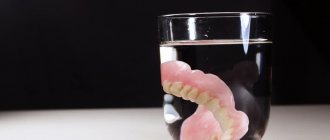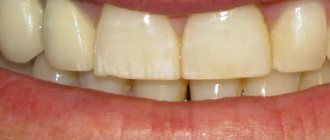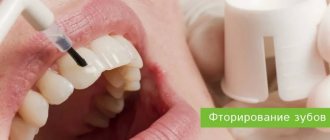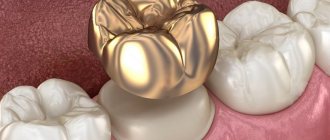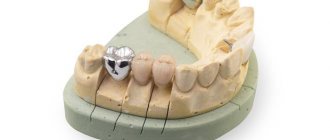29.11.2019
Many patients sooner or later go to the dental office for dental prosthetics. Today there are many different prostheses available. Metal-ceramic prostheses are very popular. Let's look at how to care for metal-ceramic teeth.
Material strength
In most cases, metal-ceramic dentures are used to replace teeth that perform an active chewing function. And it doesn’t matter whether it’s a separate crown or a bridge.
Metal-ceramic dentures are very durable and can cope with any food, even hard ones. But don’t forget that this is still a prosthesis, which means you need to be careful with it and not conduct experiments, such as cracking nuts.
Dentists note that the strength of such structures is high, but not infinite.
Service life of metal-ceramic products
Some patients are mistaken in believing that a metal-ceramic crown will last the rest of their life. Despite the strength and wear resistance, even the operation of this type of product has limitations.
Metal-ceramic dentures, which are based on simple metal, last approximately 10 to 12 years. If an alloy of gold and platinum was used for the frame, the service life will be 15 years, and sometimes more.
The service life of a metal-ceramic prosthesis, like any other, largely depends on the correctness of its manufacture and the patient’s compliance with all the rules for the care and use of this design.
Indications and contraindications for installing metal ceramics
These dental crowns are used for aesthetic prosthetics. Main indications:
- Destruction of the natural crown of a tooth by caries, trauma, non-carious lesions, etc., which cannot be restored with filling.
- Traumatic tooth fracture.
- Darkening of color or hypoplasia of enamel.
- Dental abnormalities.
- Fluorosis.
- Restoration of the lower part of the face with pathological abrasion.
- How to fix a prosthesis (removable, bridge).
- When splinting teeth for periodontitis.
- Replacing dentures.
Contraindications for installing metal-ceramic crowns are relative (sometimes it is enough to carry out preliminary treatment):
- Age up to 16 years (intact pulp).
- Teeth with fragile, thin crowns (often this applies to the lower incisors).
- Blocking bite, when the lower incisors completely overlap the upper incisors.
- Pathological abrasion of teeth and a decreasing bite (will lead to breakage of the metal-ceramic crown if the bite was not corrected and myostatic reflexes were changed before installation).
- Parafunctions of the masticatory muscles (for example, bruxism).
- Diseases of marginal periodontium due to possible functional overload of teeth.
Allergy sufferers and people with gastrointestinal diseases need to be very careful when choosing a metal frame, since the constant presence of metal can cause a deterioration in well-being over time. For such patients, a gold base is recommended. Doctors also do not recommend nickel-chromium alloys even for healthy people, since there is a tendency for general immunity to decrease and a surge in autoimmune diseases and the gastrointestinal tract.
What does dental care consist of?
Let's look at how to care for metal-ceramic dentures:
- Clean the mouth at least twice a day.
- Disposing of leftover food after every meal, including snacks.
- It is advisable to avoid the use of nicotine, tea and coffee, which can leave unpleasant stains on dentures.
- Regular visits to the doctor to remove the plaque that has formed.
- Regularly remove structures at night, placing them in a special solution, or leaving them dry.
- Avoiding exposure to too high and low temperatures, as well as their changes.
- Do not try to chew hard foods, open bottles with your teeth, etc., which causes a lot of stress and can damage the prosthesis.
Stages of installing a metal-ceramic crown
Prosthetics are more the work of a dental technician than an orthodontist. The crown will be made in 7-10 days. However, before installation, it is necessary to prepare the patient, carry out appropriate treatment if necessary, and also prepare the tooth. Therefore, you will need to visit the clinic 4-5 times (it is possible to combine several stages in one visit). If problems are discovered, the number of visits to the doctor will increase.
The presence of a pain symptom during installation of a prosthesis depends on the tooth:
- on the pulpless one the pain is not felt. However, if you ask for additional anesthesia, they will give it;
- on “living” teeth, with the root preserved, there is an unpleasant sensation, pain is felt during grinding. Anesthesia solves the problem, but it is advisable to do a test to avoid an allergic reaction.
When installing dental crowns, when a temporary prosthesis is installed, the edge of the gum may be damaged and discomfort may be felt, but this is a normal process - no medications are required. If there is increased nervous excitability, the pain threshold is low - you can take sedatives and painkillers (be sure to discuss this issue with your dentist!).
Diagnostics before installing crowns is necessary
Diagnostics
Clinical assessment of the oral cavity and tooth damage is a mandatory step before installation. This is an examination, the manipulations are painless. Orthodontist:
- examines the tooth, checking the severity of the midline (equator), the degree of destruction;
- notes fillings, degree of tooth mobility;
- identifies defects in bite and dentition;
- checks the distribution of occlusal load;
- pays attention to periodontal disease.
An x-ray may also be needed if there is inflammation or a suspected tumor. If there is no inflammatory process (it must be eliminated before installation), the tooth is cleaned of plaque and caries is treated. They are filled, if necessary, removing the nerve and additionally filling the canals.
Tooth preparation
Preparing a tooth for a metal-ceramic crown means grinding off part of the tooth so that the crown placed on top is in line with the rest of the teeth and does not interfere. The walls are shortened and smoothed, the tooth shape becomes cylindrical.
If the tooth root is healthy, the nerve is not removed. They try to keep the tooth alive, then it will not “dry out” under the crown - the service life of the metal-ceramics will increase. The abutment tooth for a metal-ceramic crown is prepared much more than when preparing to install an all-ceramic crown. Focus on the rules:
- The color of the structure, close to the natural tooth, is obtained by distributing the thickness of the ceramic: center - 1.3-1.4 mm;
- cutting part - 1.5-1.6 mm.
Like any dental procedures in the mouth, preparation is not the most pleasant, but it does not cause severe pain. At the patient’s request, the doctor will always inject an anesthetic to make him feel comfortable. When the preparation is not gentle, a significant amount of enamel and dentin (about 2 mm of hard tissue) is ground off; full anesthesia is performed with a living (intact) pulp.
Taking an impression, installing a temporary prosthesis
The orthodontist needs an impression of the upper and lower jaws to correctly make the crown so that the prosthesis is not perceived as something foreign. On the model made in plaster according to the cast, the height of the product, the angle of inclination, and the evenness of the dentition will then be checked. Sometimes an impression is made of the antagonist teeth and only the jaw where the crown will be installed.
Impression of teeth for making crowns
When making such crowns, impressions are used consisting of 2 layers:
- indicative (basic);
- clarifying (correcting).
First, gum retraction is performed under anesthesia to move it away from the tooth. The most painless method is mechanical, when the gum tray is opened using a thread soaked in a retraction compound. The groove opens, exposing the space between the tooth and the soft tissue.
An inlay is placed on the tooth, since any crown can be installed on it. The first impression is made using impression material and a special tray with perforations. Then the retraction thread is removed, a second layer (corrective) is applied, and the impression tray is again placed on the dentition according to the dental impressions. While the crown is being made, the orthodontist will install a temporary composite, and the patient will wear it for 1-2 weeks.
Manufacturing of a metal-ceramic crown
Stages of manufacturing a metal-ceramic crown:
- Creating a Casting Mold
- Formation of a metal frame
- Application and fixation of dentin, enamel, transparent layers
- Retouching with dye does not imitate carious lesions, only the necessary natural darkening.
The frame is modeled using different methods. For example, the Adapt method. The metal base is obtained by pressing a stamp. A more “jewelry” method is wax modeling. To make a metal-ceramic crown, a mock-up is first prepared from wax that accurately depicts the contours of the finished crown. Then the wax is cut off (this creates a platform for the ceramics), and a fireproof mold is prepared for casting.
The frame of the metal-ceramic crown, which has cooled after casting, is carefully removed and cleaned of the remains of the molding material, dissolving them in an acid solution. The sprue channels (through which the melt was poured into the mold) are removed and sent for a 10-minute firing. The temperature in the oven is 950-1000°C. After cooling, the metal base is adjusted to the required dimensions on the supporting tooth and ground.
Features of manufacturing a metal frame depend on the type of material:
- Soft alloys with a gold content of more than 70%. To prevent the appearance of bubbles on the surface, the finished area for ceramics is treated with a cutter or carbide boron, cleaned with steam, a solvent (for example, carbon tetrachloride or chloroform).
- Alloys of gold-palladium, gold-palladium-silver, palladium-silver and palladium-copper. Their peculiarity: they can change the color of the finished crown. Silver can “color” ceramics yellowish; copper will give a greenish tint. The finished area for the ceramic mass is treated with corundum grinding heads, cleaned in a sandblaster, and small deposits and dust are removed with steam or an organic solvent. Palladium in the base of most alloys absorbs (absorbs) air; when fired, oxygen, nitrogen and hydrogen are released, forming bubbles on the surface. Therefore, the formation of the frame includes the stage of vacuum heat treatment (degassing), when the temperature is maintained at 1000°C. The surface darkens to black.
- Nickel-chromium alloys. Corundum heads are used in processing. The ground frame is then heated to form an oxide film on the surface. Next, the metal base is polished with aluminum oxide particles using a microsandblaster and cleaned with a solvent or steam cleaner.
An opaque mass is applied in thin layers to the prepared metal-ceramic crown frame, which forms the dentin layer. For a natural depth of color, as in a healthy tooth, the first layer is the contour of the crown, setting the shape by cutting off the excess.
Further production of the metal-ceramic crown and ceramic superstructure is divided into 2 volumetric stages:
- Application of dentin coating followed by modeling.
- Condensation, i.e. vibration (for uniform distribution), blotting off excess moisture with special napkins and drying under a stream of hot air.
Manufacturing of metal-ceramic crowns
“Finger-shaped” grooves, which are very clearly visible under the enamel of a real tooth in young people, are obtained by cutting off small sections from the workpiece and smoothing the cuts with a brush. To give the metal-ceramic crown the effect of opalescence (dispersion of light), a lighter enamel mass is applied in the next layer. The final layer is colorless; it is this layer that gives the crown transparency and depth comparable to natural tooth enamel. The technician can even draw cracks (relevant for older patients), darken some areas (intertubercular space and cervical area) so that the metal-ceramic crown in the dentition looks natural.
Fitting and fixation of a metal-ceramic crown
Before installing a metal-ceramic crown, the patient wears a temporary one. All this, together with the temporary cement, is cleaned and the stump is dried. To prevent saliva from getting onto the base, a retraction thread is used. First, simply put on the crown to check the tightness of the fit. Only then does the final fixation of the metal-ceramic crown take place.
Each orthodontist has its own quality control. Some use a strip of paper, others check the installation with dental floss (a piece of paper, thread is held tightly between the teeth). After installing the crown, it is advisable to refrain from eating for 2-3 hours.


